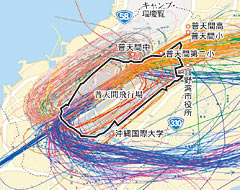Futenma helicopters’ routine operations significantly extended beyond limits of their flight path

Helicopter flight situation chart issued by the Okinawa Defense Bureau for Futenma Air Station based on the results of the survey for the month of June, 2010.
October 7, 2011 Ryukyu Shimpo
On October 6, the Okinawa Defense Bureau released the results of a survey conducted from January 1, 2010 until March 31, 2011 on the flight activities of rotary-wing craft based in the U.S. Marine Corps Futenma Air Station. Many helicopter flight activities went significantly beyond the traffic patterns reviewed and agreed upon in 2007 by the governments of Japan and the United States.” Nevertheless, the Bureau commented that this survey result “does not mean that they have not kept to the agreement.”
The survey did not indicate the specific number of flight activities observed straying off the routes set in the traffic pattern. All six people surveyed by the bureau for their view as experts are professional pilots or air traffic controllers of Japan Self-Defense Forces (JSDF).
Track charts are collated by months, with flight activities of off-trail traffic patterns observed. To a large extent, these flights were instances of going too far out of a traffic pattern over the airfield to the southwest from the north over places such as Futenma, Oyama, Mashiki and Ojana in Ginowan City, on circular flights around the base when landing or departing, but included flight in a straight line on the extended runway without going through the traffic pattern for helicopters.
With regard to wide-turn flights, the people responsible for the survey represented expert opinion by saying, “In emergency training with a certain traffic pattern, the helicopters might sometimes choose to land at the airport safely with a gentle turning angle. The Marine Corps must do some of its training in the context of assuming emergency situations,” therefore indicating that flight protrusion beyond agreed limits was unavoidable.
The flight path for the Futenma Air Station was agreed on by the governments of Japan and the United States in 2007 after a U.S. Marine helicopter crashed onto Okinawa International University. According to the traffic pattern agreed upon, wherever possible aircraft must fly around the runway to flying avoid over residential areas. This is the first time that the Okinawa Defense Bureau has investigated the flight situation around Futenma Air Station in earnest, and has published result of its survey. The Ministry of Defense requested that to the maximum extent possible U.S. military operate their aircraft within the traffic pattern, and received a response from the U.S. side to the effect that they agreed to strictly comply with this.
(English Translation by T&CT, Mark Ealey)
Previous Article:Okinawan telecommunications firm sells Taiwanese smartphone
Next Article:40th anniversary coin of Okinawa’s reversion will be issued with a full-color Shuri Castle design
[Similar Articles]
- Nighttime Osprey flights double, conflicting with claims of burden reduction
- Japanese government proclaims Osprey to be safe, and will deploy them to Futenma
- US Marine Corp to deploy Osprey at Futenma Air Station
- MCAS Futenma 2018 air traffic survey results show that established flight path deviations are becoming the norm
- [Extra] Government takes step towards building new US base in Henoko amid protest
 Webcam(Kokusai Street)
Webcam(Kokusai Street)


